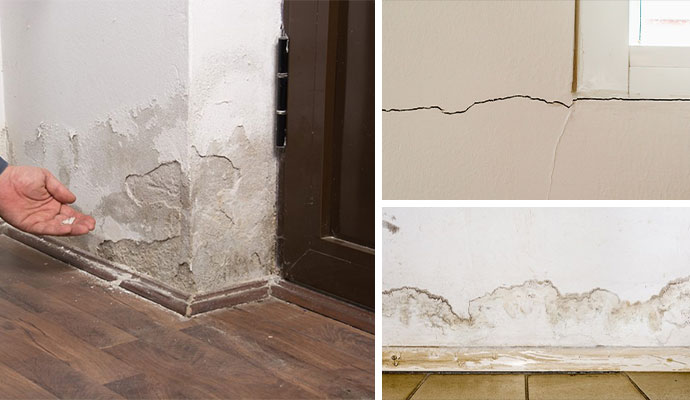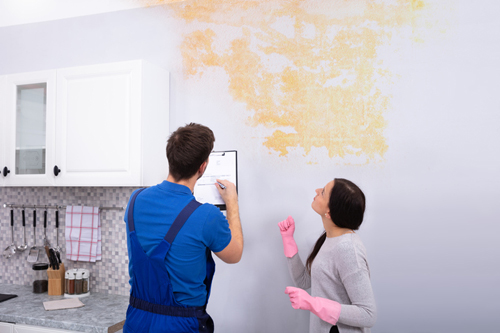What are your ideas with regards to How to Find and Repair Water Leaking in the Wall?

Water stains on wall surfaces are not enjoyable to the eyes. Your residence must be without discolorations on the walls, roof, or floorings. That is the optimal state of a residence as well as its structures. Sometimes it appears nearly unavoidable to experience water discolorations on walls in residences.
Homeowners residing in humid areas continuously manage the concern of water stains on wall surfaces. However that does not need to be the case for you. With precise and well-shaped info on the sources of water spots and also timely repair procedures, you will constantly be an action ahead of such occurrences. So, this write-up guarantees to be a handy guide for you.
3 Common Root Causes Of Water Discolorations on Walls
In contrast to common belief, water stains on wall surfaces do not constantly stem from bad structure materials. There are several root causes of water discolorations on walls. These include:
Poor Water drainage
When making a structure plan, it is important to make certain adequate drain. This will certainly protect against water from seeping into the wall surfaces. Where the water drainage system is obstructed or nonexistent, underground wetness accumulates. This links to excessive dampness that you observe on the wall surfaces of your structure.
The leading reason of damp wall surfaces, in this case, can be a bad drain system. It can additionally be due to bad administration of sewer pipelines that run through the building.
Moist
When warm wet air meets with dry chilly air, it triggers water droplets to form on the wall surfaces of structures. This takes place in bathrooms and kitchen areas when there is heavy steam from food preparation or showers. The water droplets can stain the surrounding walls in these parts of your home as well as spread to other locations.
Moist or condensation influences the roof covering and also wall surfaces of structures. This creates them to show up darker than various other locations of the residence. When the wall surface is wet, it creates a suitable environment for the growth of microbes and fungi. These might have negative impacts on health and wellness, such as allergic reactions as well as breathing conditions.
Pipe Leaks
The majority of residences have a network of water pipes within the walls. This makes certain that the pipelines are well away from the reach of destructive rats. It always increases the stability of such pipes, as there is little oxygen within the walls. This dissuades rust.
Yet, a drawback to this is that water leakage influences the walls of the building and also causes prevalent damages. A telltale sign of defective pipes is the look of a water stain on the wall surface.
Water Stains on Wall Surface: Repair Work Tips
House owners would generally desire a quick fix when handling water spots. Yet, they would certainly soon understand this is detrimental as the water stains persist. So, below are a few handy ideas that will certainly direct you in the repair of water stains on wall surfaces:
- Constantly repair the source of water spots on walls
- Involve the help of expert fixing services
- Method regular sanitation and clear out clogged up sewage systems
- When developing a home in a waterlogged location, make certain that the workers conduct appropriate grading
- Tiling locations that are prone to high condensation, such as the kitchen and bathroom, helps in decreasing the build-up of wet
- Dehumidifiers are additionally helpful in keeping the wetness levels at bay
Pro Pointer
A houseplant in your home also enhances its moisture. If the home is currently moist, you may want to present houseplants with minimal transpiration. An instance of ideal houseplants is succulents.
Conclusion
No one desires to have water discolorations on walls in their home, it can occur to the finest of us. This write-up gives you leverage, as you now understand just how to manage this mishap if it does occur.
It is always best to recruit expert solutions to aid deal with the problems in your home.
Sometimes it seems practically unavoidable to experience water spots on walls in homes.
Contrary to popular belief, water discolorations on wall surfaces do not constantly stem from bad structure materials. There are a number of causes of water spots on wall surfaces. The water droplets can stain the surrounding walls in these components of your residence as well as spread to other areas.
Here are a few practical ideas that will direct you in the repair work of water spots on walls:
What To Do About A Water Stain On The Ceiling
Why This is Important
Not only are water stains a cosmetic issue, but they can also indicate that there is a leak in the home that needs to be fixed. Sometimes, this may be the first indicator of a bigger problem brewing or may have been a one time leaky issue. It is important to investigate to make sure it is under control before you possibly have thousands of dollars in repairs.
Identify the Cause of the Water Stain on the Ceiling and Where to Start
It is important to identify the cause of the water stain on the ceiling first so you can fix it. Start first with the roof to see if there are leaky shingles or missing shingles, missing flashing, or weakened seals around roof vents. You may need to get on top of the roof to look or call a professional to check for you. It is possible that water is coming into the home from the roof. So you will want to have the professional take a look to see if this is the issue.
Also, look in the attic to see if there is a pool of water and that will also help you to know if there is water leaking into the home.
Radiator or Air Handler on 2nd floor
In colder parts of the country, there may be a radiator on the second floor. Radiators are used to keep rooms warm in the cold months and do wear out or need replacing. Does the radiator have a pool of water underneath it or any dripping? If yes, this could be the problem and causing the water stain on the ceiling. Check the model of the radiator and see if it is something you can do yourself or call a professional to check the body, pipe, and the valve for leaks.
The same is true for those who have an air handler on the second floor. Did your AC stop working? Or do you see water leaking? The drip pan (if you have one) on an HVAC unit collects the water and it can become clogged and back up. The float switch (again, if you have one) will activate as soon as the water reaches a certain level and shut down the HVAC unit, thus not allowing the water to continue to flow. Make sure the HVAC doesn’t become clogged and checking this monthly is a good idea.
Upstairs Bathroom Can Cause a Water Stain on the Ceiling
Bathrooms are often the culprit as caulking wears out after about 10 years and needs replacing. Is the home older than 10 years? This may be the issue. While checking the caulking in the bathroom around the sinks, toilets, and shower/bath, also check for black mold in the shower. Might as well rule everything out while you are looking for the source.
Other areas to look at are toilets clogging and overflowing. Do you see water near the toilet on the floor? This could be the seal is broken on the toilet and it needs replacing. Also, adding caulk to the toilet to connect it to the floor is a good idea. If the toilet is continuously running, you can shut off the water and do the water meter test.
Write down the number on the water meter and then turn off the water for three hours. When you turn it back on, check the number on the water meter. If it has increased, then you have a leak in the indoor plumbing.
Taking care of these areas is essential as sewer gases can also be escaping. Sometimes these issues will soak the ceiling below and clog in sinks and drains in the shower can also cause flooding in a bathroom.
Put a Drop Cloth on the Floor
- With goggles on and gloves, put a drop cloth on the floor. Then, take 3 glasses of warm water and one cup of bleach and mix it together. Set up a ladder and climb up to the stain. Use a sponge that is soaked in the concoction to rub it on the water stain to get it to come off. Take a spray bottle of plain water and spray the stain to get the bleach mixture off. This is important because you want to be able to prime it and paint it. Take a dry towel and rub the stain to help it dry faster.
- Next, put painters tape around the ceiling if the spot is near the walls.
Apply an Oil Based, Stain Blocking Primer
Apply an oil based, stain blocking primer that is mold resistant that matches the ceiling. It is important to put the primer on first so the paint doesn’t soak into the ceiling. If you have a flat ceiling, you can use a paint roller with an extension to apply it. Once the primer has dried, apply the paint. If you have a textured ceiling, a spray on primer might work better.
Choose a Latex or Alkyd Ceiling Paint
The latex ceiling paint is water-based and dries faster than the oil-based paints and also is thicker than wall paint. Make sure that the paint matches the ceiling color. Using a roller, paint it on over the primer and let it dry for up to four hours. Then, apply a second coat and let it dry. The second coat should make the stain disappear.
https://insideandoutpropertyinspectors.com/water-stain-on-ceiling/

As an enthusiastic reader about How to Find and Repair Water Leaking in the Wall, I assumed sharing that piece of content was a smart idea. For those who enjoyed our post if you please do not forget to pass it around. Thanks a bunch for your time. Visit again soon.
Book Maintenance
Comments on “Beating Back Water Stains - Wall Check And Repair Solutions”